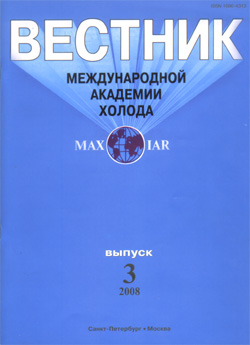
Modified ozone-friendly refrigerant mixtures as substitutes for R22

Annotation
New modified ozone-friendly mixed refrigerants have been offered to replace the ozone-destroying R22 in refrigerating equipment: 0.8RC318/0.2E170, 0.96R507a/0.04E170 and 0.8R507a/0.2E170. A constant-volume piezometer was used to study the pressure of mixed refrigerants on the boiling line in the unit with a liquid expansion thermostat. A heat pump bench was used to test the performance of the modified refrigerants employing mineral and synthetic refrigerator oils. The offered way to modify ozone-friendly refrigerants makes it possible to expand the assortment of known ozone-friendly refrigerant mixtures for the working refrigerating equipment. The results of this research will help to considerably cut down the expenses for retrofitting such refrigerating equipment.
Keywords
Постоянный URL
Articles in current issue
- Simulation and a mathematical program for calculating the value of effective radiation
- The refrigerant’s future: The phase down of HFCs and its consequences
- A technique for optimization of the parameters of the cryostatted screen in a cryovacuum test bench
- Mathematical model for the cleaning of fat-containing wastewater by ozonation at refrigerating enterprises
- A pilot study of aero- and thermodynamic processes in the apertures equipped with heated air curtains
- Results of monitoring temperature fields in the basement of the Triumph Stadium in Yakutsk
- Manufacturing dried and salt-cured fish products with various flavours from perch with the use of sauces
- Generalized correlations of the isobaric heat capacity on the saturated liquid line for freon mixtures
- Heat exchange calculation for the process of air movement in surface air coolers
- Radiating thermoelectric device with power recuperation
- Possibilities of employing cryogenic optoelectronic systems for detection of asteroids
- The problem of the accuracy of temperature measuring by means of a thermographic camera
- Optimization of operation modes in a refrigerating unit with the accumulator of natural cold using the method of thermoeconomic analysis
- Features and efficiency of applying heat pump units for heating buildings at railway hump yards
- Frictional pressure drop in a boiling refrigerant flow in pipes
- Analysing overall performance of a reciprocating expander at variable durations of admission process
